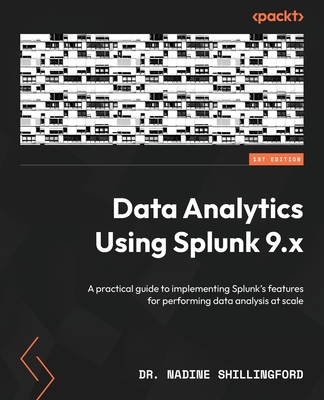Data Analytics Using Splunk 9.x: A practical guide to implementing Splunk's features for performing data analysis at scale
暫譯: 使用 Splunk 9.x 的數據分析:實施 Splunk 功能以進行大規模數據分析的實用指南
Shillingford, Nadine
- 出版商: Packt Publishing
- 出版日期: 2023-01-20
- 售價: $1,690
- 貴賓價: 9.5 折 $1,606
- 語言: 英文
- 頁數: 336
- 裝訂: Quality Paper - also called trade paper
- ISBN: 1803249412
- ISBN-13: 9781803249414
-
相關分類:
Splunk
海外代購書籍(需單獨結帳)
相關主題
商品描述
Make the most of Splunk 9.x to build insightful reports and dashboards with a detailed walk-through of its extensive features and capabilities
Key Features
- Be well-versed with the Splunk 9. x architecture, installation, onboarding, and indexing data features
- Create advanced visualizations using the Splunk search processing language
- Explore advanced Splunk administration techniques, including clustering, data modeling, and container management
Book Description
Splunk 9 improves on the existing Splunk tool to include important features such as federated search, observability, performance improvements, and dashboarding. This book helps you to make the best use of the impressive and new features to prepare a Splunk installation that can be employed in the data analysis process.
Starting with an introduction to the different Splunk components, such as indexers, search heads, and forwarders, this Splunk book takes you through the step-by-step installation and configuration instructions for basic Splunk components using Amazon Web Services (AWS) instances. You'll import the BOTS v1 dataset into a search head and begin exploring data using the Splunk Search Processing Language (SPL), covering various types of Splunk commands, lookups, and macros. After that, you'll create tables, charts, and dashboards using Splunk's new Dashboard Studio, and then advance to work with clustering, container management, data models, federated search, bucket merging, and more.
By the end of the book, you'll not only have learned everything about the latest features of Splunk 9 but also have a solid understanding of the performance tuning techniques in the latest version.
What you will learn
- Install and configure the Splunk 9 environment
- Create advanced dashboards using the flexible layout options in Dashboard Studio
- Understand the Splunk licensing models
- Create tables and make use of the various types of charts available in Splunk 9.x
- Explore the new configuration management features
- Implement the performance improvements introduced in Splunk 9.x
- Integrate Splunk with Kubernetes for optimizing CI/CD management
Who this book is for
The book is for data analysts, Splunk users, and administrators who want to become well-versed in the data analytics services offered by Splunk 9. You need to have a basic understanding of Splunk fundamentals to get the most out of this book.
商品描述(中文翻譯)
充分利用 Splunk 9.x,透過詳細的功能和能力介紹,建立有洞察力的報告和儀表板
主要特點
- 熟悉 Splunk 9.x 的架構、安裝、上線和數據索引功能
- 使用 Splunk 搜索處理語言創建高級可視化
- 探索高級 Splunk 管理技術,包括叢集、數據建模和容器管理
書籍描述
Splunk 9 在現有的 Splunk 工具上進行了改進,新增了重要功能,如聯邦搜索、可觀察性、性能改進和儀表板功能。本書幫助您充分利用這些令人印象深刻的新功能,準備一個可以用於數據分析過程的 Splunk 安裝。
本書從介紹不同的 Splunk 組件開始,例如索引器、搜索頭和轉發器,逐步帶您了解使用 Amazon Web Services (AWS) 實例進行基本 Splunk 組件的安裝和配置說明。您將把 BOTS v1 數據集導入搜索頭,並開始使用 Splunk 搜索處理語言 (SPL) 探索數據,涵蓋各種 Splunk 命令、查找和宏。之後,您將使用 Splunk 的新儀表板工作室創建表格、圖表和儀表板,然後進一步處理叢集、容器管理、數據模型、聯邦搜索、桶合併等。
在書籍結束時,您不僅會學到有關 Splunk 9 最新功能的所有知識,還會對最新版本中的性能調優技術有深入的理解。
您將學到什麼
- 安裝和配置 Splunk 9 環境
- 使用儀表板工作室中的靈活佈局選項創建高級儀表板
- 理解 Splunk 授權模型
- 創建表格並利用 Splunk 9.x 中各種可用的圖表類型
- 探索新的配置管理功能
- 實施 Splunk 9.x 中引入的性能改進
- 將 Splunk 與 Kubernetes 整合,以優化 CI/CD 管理
本書適合誰
本書適合希望熟悉 Splunk 9 提供的數據分析服務的數據分析師、Splunk 用戶和管理員。您需要對 Splunk 基礎知識有基本了解,以便充分利用本書。
目錄大綱
1. Introduction to Splunk and its Core Components
2. Setting Up the Splunk Environment
3. Onboarding and Normalizing Data
4. Introduction to SPL
5. Reporting Commands, Lookups, and Macros
6. Creating Tables and Charts Using SPL
7. Creating Dynamic Dashboards
8. Licensing, Indexing, and Buckets
9. Clustering and Advanced Administration
10. Data Models, Acceleration, and Other Ways to Improve Performance
11. Multisite Splunk Deployments and Federated Search
12. Container Management
目錄大綱(中文翻譯)
1. Introduction to Splunk and its Core Components
2. Setting Up the Splunk Environment
3. Onboarding and Normalizing Data
4. Introduction to SPL
5. Reporting Commands, Lookups, and Macros
6. Creating Tables and Charts Using SPL
7. Creating Dynamic Dashboards
8. Licensing, Indexing, and Buckets
9. Clustering and Advanced Administration
10. Data Models, Acceleration, and Other Ways to Improve Performance
11. Multisite Splunk Deployments and Federated Search
12. Container Management











